

|

|
|||

|
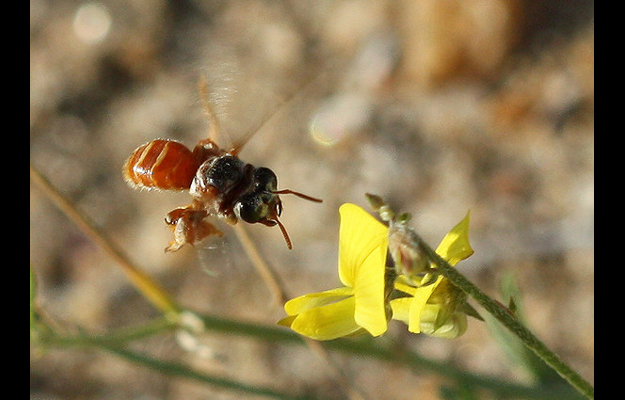
|
||
|
Bee With No Stripes Discovered in Kenya
It has a black head and a bright orange body, and velociraptor-like claws on its hind legs. It lives underground, not in a hive. And it lives by itself, instead of in the huge colonies we're used to. The world's newest-known bee has been named Samba turkan The hot, dusty bush and deserts of Turkana in Northern Kenya are one of our planet's most remote and exciting regions to explore. This harsh landscape is famous for its long record of human and vertebrate evolution - as part of the work of the Leakey family. The Turkana Basin holds the shimmering Lake Turkana that lies in the middle of the African Great Rift Valley. Turkana is also a region with unique biodiversity, that has adapted to the hot, dry conditions. At first look deserts and drylands may appear bleak and devoid of life. However, nothing could be further from the truth: these regions are teeming with life, but living things here have adapted to the extreme conditions, and often stay hidden or dormant for long periods of time. After brief rains life erupts with an unrivaled exuberance to make the most of the flowers and opportunity. This part of the world is particularly rich in different kinds of bees. Being bright orange, Samba turkan are easy to spot as they zip about the low-growing flowers that appear after the rains. These solitary bees start their day early in the morning racing to the flowers to gather pollen. As things dry up really quickly in the Turkana heat, they only have a couple of days to gather enough pollen for their larvae. The females nest in the ground, digging tunnels in the sand, where they make small cells that hold the stores of pollen and their young. Each female collects food for her own larvae and cares for her own nest individually - there's no sharing and cooperation like in the more familiar honeybees. The female Samba bees lay eggs on the stored pollen. If you're wondering what the males are doing, so are we! We haven't found any yet, but they are likely just focused on mating - we can already see that they don't help at the nest or collect pollen. ~excerpt and photo from: http://voices.nationalgeographic.com/2015/02/25/a-new-bee-from-turkana-kenya/?utm_source=Twitter&utm_medium=Social&utm_content=link_tw20150226voices-beestripes&utm_campaign=Content&sf7662996=1 Send this link to anyone you think would be interested in reading this entry. |

|
|||

|

|
||
|
Vivian Maier, The Mysterious Nanny Behind A Trove Of Brilliant Street Photography
The story of Vivian Maier is probably one of the art world's most compelling mysteries. A nanny by profession, she was an alarmingly talented and vastly prolific photographer whose keen eye for the mundane produced some of the 20th century's most intriguing works of street photography. The juxtaposition of being a lifelong caretaker in one moment, chasing kids and bickering with parents, and a relentless documentarian on the other, churning out rolls of film a day, is enigmatic in itself. But the real kick is that Vivian Maier is a name no one truly knew until about 2007. It was then that a former real estate agent named John Maloof unknowingly purchased a box of her photographic negatives for $400. Fast forward through a heavy dose of research and detective work, and you have "Finding Vivian Maier," the Oscar-nominated film that recounts the life of a woman the art world reveres, but no one actually seems to know. This is an artist who used her occupation as a nanny to allow her to execute her work. She was an artist first; an extremely private person who made thousands of photographs in her lifetime, never really showing them to anybody. ~ excerpt and photo from: http://www.huffingtonpost.com/2015/02/12/vivian-maier-documentary-oscars_n_6664148.html?utm_hp_ref=mostpopular&utm_content=buffer7726c&utm_medium=social&utm_source=twitter.com&utm_campaign=buffer" target=_blank Send this link to anyone you think would be interested in reading this entry. |

|
|||

|

|
||
|
Fog
Driving across our Sanibel Causeway today reminded me of this photograph. All day today the fog muted our island. Colors are gray. Sounds are softer. The air is wet and cool. And still the birds go about their business of flying, the fisher-people work busily to bring in stone crabs and people still walk the beach, because, after all, this is a wonderful day. Any day we are alive, with our loved ones and friends caring for us and providing us all means of support, we are truly lucky. I took this photograph years ago when visiting the northeast U.S. with someone who once was a friend. This was in the film days and when I received the slide I fell in love with the image. In those days "Coastal Living" magazine had an annual feature that included images of the coast submitted by readers. I submitted this photo and was amazed to see it win a place and publication, along with 4 other photos, that year. I still love the image and it evokes thoughts of gentle times. original photo by dmdart Send this link to anyone you think would be interested in reading this entry. |

|
|||

|

|
||
|
Scientists have discovered nature's newest strongest material
It's as strong as steel and tough as a bulletproof vest, capable of withstanding the same amount of pressure it takes to turn carbon into a diamond. Scientists have discovered nature's newest strongest material, and it comes from a sea snail. British researchers announced that the teeth of shelled, aquatic creatures called limpets are the strongest biological material on Earth, overtaking the previous record-holder, spider silk. The teeth, which are so small they must be examined with a microscope, are composed of very thin, tightly-packed fibers containing a hard mineral called goethite. Limpets use them to scrape food off of rocks. The teeth also bested several man-made materials, including Kevlar, a synthetic fiber used to make bulletproof vests and puncture-proof tires. The amount of weight it can withstand can be compared to a strand of spaghetti used to hold up more than 3,300 pounds, the weight of an adult female hippopotamus. ~excerpt from: http://www.washingtonpost.com/news/morning-mix/wp/2015/02/18/scientists-have-discovered-natures-newest-strongest-material-and-it-comes-from-a-sea-snail/ Send this link to anyone you think would be interested in reading this entry. |

|
|||

|

|
||
|
National Margarita Day! Today!
5 o'clock? original photo by dmdart Send this link to anyone you think would be interested in reading this entry. |

|
|||

|

|
||
|
Pangolin
World Pangolin Day (Today!) is an opportunity for pangolin enthusiasts to join together in raising awareness about these unique mammals and their plight. Pangolin numbers are rapidly declining, particularly in Asia. Pangolin trafficking is now recognized as a serious problem in Africa. Pangolins, also known as scaly anteaters, are unique creatures that are covered in hard, plate like scales. They are insectivorous (feeding on insects) and are mainly nocturnal. Their name, "pangolin", is derived from the Malay word "pengguling", which loosely translates to "something that rolls up". Together, the eight species comprise their very own Order: Pholidota. In 2013, an estimated 8,125 of these shy creatures were confiscated in 49 instances of illegal trade across 13 countries. Because seizures represent just 10 to 20 percent of the actual illegal trade volume, this strongly suggests that approximately 40,625 to 81,250 pangolins were killed in just one year. An estimated one million of them have been traded and killed within the past ten years. This makes them the most trafficked animals in the world. The demand for pangolins comes mostly from China, where pangolin scales are unfortunately believed to be a cure-all of sorts and pangolin flesh is considered a delicacy. In Vietnam, pangolins are frequently offered at restaurants catering to wealthy patrons who want to eat rare and endangered wildlife. There is no evidence to support claims regarding medicinal properties of pangolin scales or any other part of the pangolin. According to the International Union for the Conservation of Nature (IUCN), virtually no information is available on population levels of any species of pangolin. These species are rarely observed due to their secretive, solitary, and nocturnal habits, and there has been little research on their population densities. However, all species are thought to be in decline, with some more rapidly so than others - particularly the Asian species. ~excerpt from: http://pangolins.org/world-pangolin-day/ ~image from: http://whitmanpioneer.com/wp-content/uploads/2014/12/pangolin_05.jpg Send this link to anyone you think would be interested in reading this entry. |

|
|||

|

|
||
|
One Fruit Tree - 40 Fruits
Van Aken's Tree of 40 Fruit, an invention that's just what it sounds like, is capable of producing 40 different varieties of fruit - plums, peaches, apricots, nectarines, cherries and others. The 42-year-old sculptor and art professor at Syracuse University created his first multi-fruit tree back in 2008, by grafting together branches from different trees. He intended to produce a piece of natural art that would transform itself. He thought of the tree as a sculpture, because he could, based on what he grafted where, determine how it morphed. Today, there are 18 of these wondrous trees across the country, with three more being planted this spring in Illinois, Michigan and California. Seven are located in New York - including the very first Tree of 40 Fruit that's still on the Syracuse campus - and six more are in a small grove in Portland, Maine. While it takes precision, the grafting required to create these multi-fruit trees is not that complicated a process. Van Aken, who grew up on a farm in Pennsylvania, takes a slice of a fruit tree that includes buds and inserts it into a matching incision in a host tree, one that's been growing for at least three years. He then wraps electrical tape around the spot to hold the pieces together. When all goes well, the veins of the different trees flow into each other so that they share a vascular system. ~excerpt and photo from: http://www.smithsonianmag.com/innovation/a-tree-grows-40-different-types-of-fruit-180953868/ Send this link to anyone you think would be interested in reading this entry. |

|
|||

|

|
||
|
Forget the 3D Printer: 4D Printing Could Change Everything
Scientists at MIT are using a new technique that could print responsive objects from water pipes to sneakers that adapt to their surroundings on their own. At the Massachusetts Institute of Technology, researchers were trying to come up with a way of describing the objects they were creating on 3D printers - objects that not only could be printed, but thanks to geometric code, could also later change shape and transform on their own. The process they developed - which turns code into "smart objects" that can self-assemble or change shape when confronted with a change in its environment - could very well pop up in a number of industries, from construction to athletic wear. Normally, we print things and we think they're done. But we want them to be able to transform and change shape over time. And we want them to assemble themselves. ~excerpt and photo from: tp://www.smithsonianmag.com/innovation/Objects-That-Change-Shape-On-Their-Own-180951449/ Send this link to anyone you think would be interested in reading this entry. |

|
|||

|
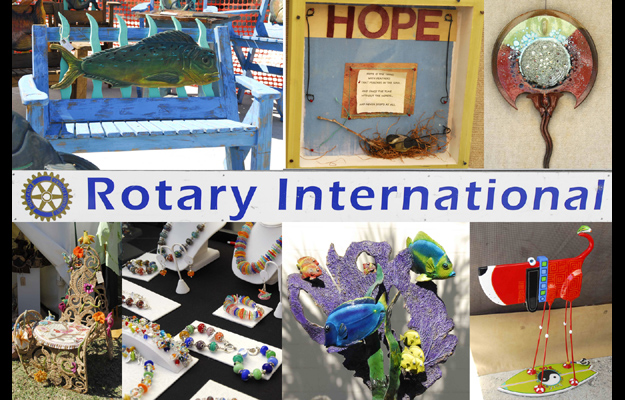
|
||
|
Sanibel Island Rotary Art Show
Since I occasionally photograph for SantivaChronicle.com, I covered the Rotary Art Show that took place yesterday. Take a look here and see some of the wonderful art at the show: http://santivachronicle.com/Content/Photo-Gallery/Photo-Gallery/Photo-Gallery/Rotary-Arts-and-Crafts-Fair-2015/7/7/40 original photo by dmdart Send this link to anyone you think would be interested in reading this entry. |

|
|||

|

|
||
|
Tibi Tibi Neuspiel's Strange Sandwiches
Toronto-based artist Tibi Tibi Neuspiel Tibi Tibi's works are highly approachable, wonderfully absurd, and visually appealing. And just a little bit ridiculous. They might not exactly evoke a "fine" art aesthetic, but his work is not light on artistic merit or craftsmanship. Incredibly, they are not photographs of real sandwiches, but rather beautifully crafted encaustic wax sculptures. Rather than relying on the veneer of curious appeal, his work instead uses this bizarre allure as a vehicle to draw the viewer into the deeper levels of the work. The image and the words above are excerpted from here: http://ridiculouslyinteresting.com/2011/10/13/tibi-tibi-neuspiels-subversive-sandwiches/ and you can see more of his work here: http://tibitibi.com/ Send this link to anyone you think would be interested in reading this entry. |

|
|||

|
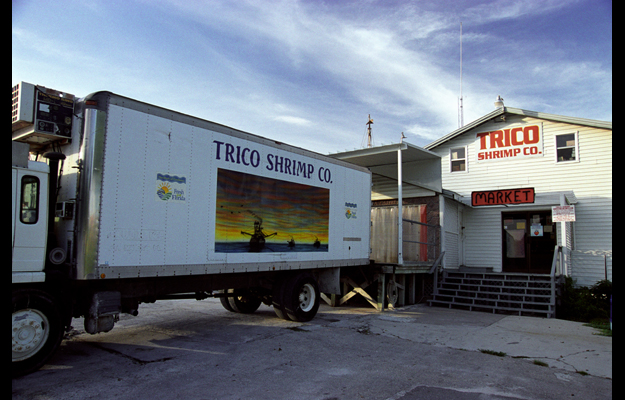
|
||
|
Trico Shrimp Company
The back roads of Fort Myers, Florida led me here. I loved the painting on the side of the truck. original photo by dmdart Send this link to anyone you think would be interested in reading this entry. |

|
|||

|
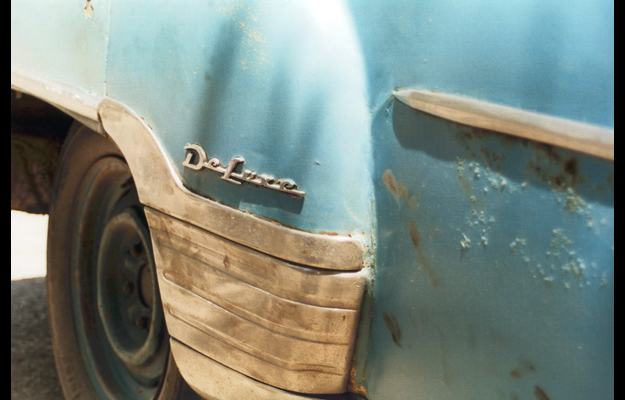
|
||
|
Cuba
We all know about the old American cars that drive the streets. In 1999 I was fortunate enough to travel with a photography group to Cuba. This is one image. original photo by dmdart Send this link to anyone you think would be interested in reading this entry. |

|
|||

|
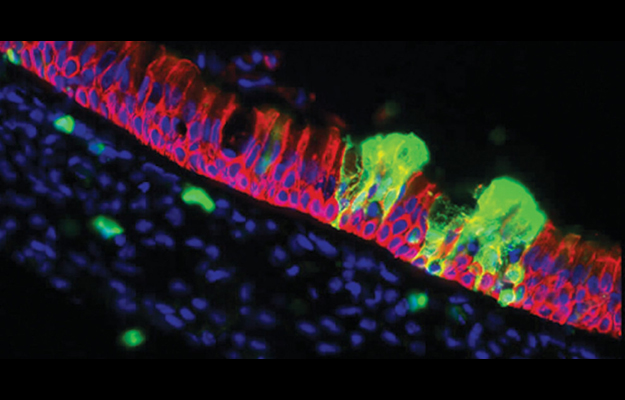
|
||
|
How The Measles Virus Became A Master of Contagion
[Image: Measles-infected immune cells (green blobs) pass on the viruses to epithelial cells lining the nose.] Measles is among the most contagious viruses on Earth. Every infected person infects between 12 and 18 other people. As a virus, it has to do three things in order to avoid extinction: it has to invade a new host, make copies of itself, and get those copies to another host. People get infected with measles viruses by breathing them into their lungs. The lining of the lungs contains immune cells that destroy incoming invaders and kill off infected cells. The measles virus boldly attacks these very sentinels. It uses a molecular key to open a passage into the immune cells. Once inside, it starts making new viruses that infect other immune cells. The virus-laden cells then creep from the windpipe to the lymph nodes, which are crowded with still more immune cells. It's like a walk in Disneyland, except inside a person's body. From the lymph nodes, infected immune cells spread the virus throughout the body. If the virus manages to slip into the nervous system, it can cause permanent brain damage. After several days of multiplying, the virus starts making preparations to leave its host. Some of the infected immune cells creep up into the nose. The interior lining of the nose is made up of sheets of epithelial cells. The immune cells nuzzle up to the epithelial cells. A protein on their surface, made by the viruses, fuses them to the epithelial cells, allowing the virus to cross over. Now the measles virus is another step closer to leaving its host and finding a new one. Each infected epithelial cell starts making huge numbers of new measles viruses, which it dumps out into the nasal cavity, where they can get exhaled. Meanwhile, the infection also damages the upper airway, causing infected cells to rip free and get coughed out of the body. People sick with measles release clouds of virus-laden droplets. The big droplets fall quickly to the ground or other surfaces, where they can stay infectious for hours. The small droplets meanwhile rise into the air, where they are lofted by currents and can deliver measles to people far away. The sheer number of viruses produced by each sick person, along with the adaptations the viruses have for penetrating deep into the airway, make them tremendously contagious. If someone gets sick with measles, up to ninety percent of people in the same home who aren't already immune will get sick, too. And because infected people can transmit the virus for days before symptoms emerge, the virus can spread to many homes before anyone realizes an outbreak is underway. And the virus droplets remain contagious in a room for several hours after the infected person has left. The contagion of measles is part of a "one-and-done" strategy that the viruses have evolved. After people recover from measles infections, their immune systems will protect them for life. As a result, the virus needs to be highly contagious for its long-term survival. This strategy also means that measles vaccines can be extremely effective. By teaching people's immune systems what the measles virus looks like, vaccines provide protection for life. Measles only infects humans. If we could make our species measles-free, that would mean the virus had become extinct, never to return. And the life cycle of measles actually makes it possible to block its transmission from person to person. It's very rare for infections to last more than a couple weeks, so that there isn't the risk of people surreptitiously spreading the disease for years. People who do get sick won't get sick again, which takes them out of the pool of potential hosts. And we are fortunate to have a safe, effective way to break measles transmission: a vaccine. Before the development of measles vaccines in the early 1960s, 7 to 8 million children died around the world every year. In 2014, that figure was down to 145,000 deaths. The World Health Organization estimates that between 2000 and 2013, measles vaccination prevented 15.6 million deaths. ~excerpt and image from: http://phenomena.nationalgeographic.com/2015/02/05/how-the-measles-virus-became-a-master-of-contagion/ Send this link to anyone you think would be interested in reading this entry. |

|
|||

|
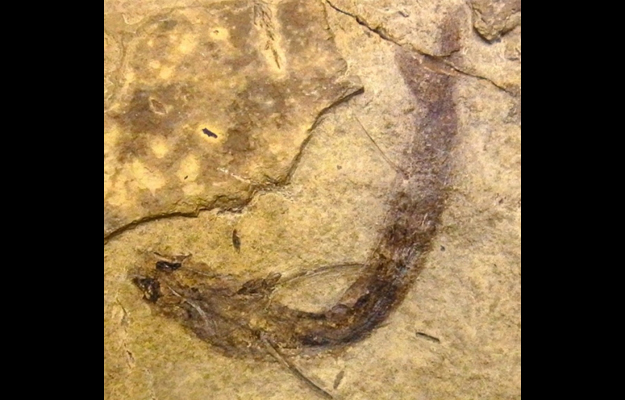
|
||
|
300 Million Year Old Fish Likely Had Color Vision
Scientists have discovered rod and cone cells while examining the fossil of 300-million-year-old fish eyes. The findings suggest that the fish likely possessed color vision. Scientists found the fossil of a fish that measured about 10 centimeters long. The fossil was found in Hamilton Quarry, near Hamilton in Kansas. Researchers suggest that Hamilton Quarry was a shallow lagoon in ancient times and fossils discovered from the area are usually well preserved as they got buried very swiftly in the sediments of the lagoon. Rods and cones are not usually preserved, because these soft tissues are more fragile. However, the fossil of the latest fish was so well-preserved that rod and cone cells are still visible in the eyeballs under an electron microscope. Scientists had long believed that modern eyes developed millions of years ago and the latest discovery provides a definitive proof. ~excerpt and photo from: http://www.techtimes.com/articles/22888/20141224/scientists-discover-rods-and-cones-in-300-million-year-old-fish-eyes-what-findings-suggest.htm Send this link to anyone you think would be interested in reading this entry. |

|
|||

|
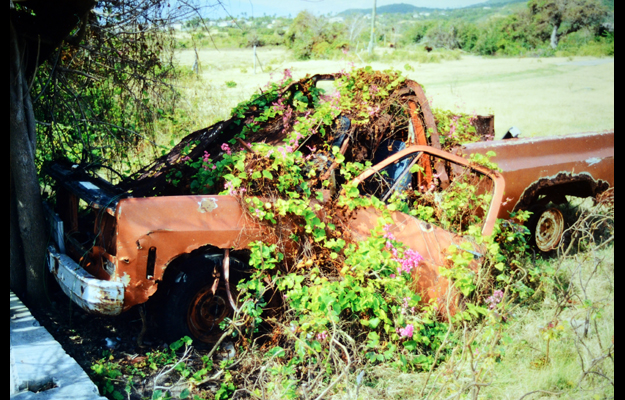
|
||
|
Abandoned on Nevis
Nevis is a small island in the Caribbean Sea. It is conical in shape with a volcanic peak known as Nevis Peak at its center. The island is fringed on its western and northern coastlines by sandy beaches that are composed of a mixture of white coral sand with brown and black sand which was eroded and washed down from the volcanic rocks that make up the island. There are many back roads and paths to travel. I found this abandoned and overgrown truck on one of my outings. original photo by dmdart Send this link to anyone you think would be interested in reading this entry. |

|
|||

|

|
||
|
Artist Kelvin Hair
Kelvin Hair was born into art. His father was Alfred Hair, the founder of the Highwaymen. The Highwaymen is the name given to a loosely associated group of young African-American artists living in the Fort Pierce area of Florida. They would sell their works, often still wet, door to door to various businesses, on the roadside or out of car trunks. They painted on Upson board and they painted fast, often painting many works simultaneously. They painted what they felt: no rules. Alfred Hair was inducted into the Florida Artists Hall of Fame in 2004. I met Kelvin Hair yesterday, at an excellent art show, and am now the very happy owner of the painting shown here. To me, this painting encompasses what I envision when I think of Highwaymen paintings. Kelvin created paintings from an early age and has honed his skill through the years. He is well known and shows his vision, expressiveness, imagination and artistic integrity in each work he creates. The information here is excerpted from Kelvin Hair's brochure, but you can read more and see more at his website: http://www.khairart.com/ Another excellent source of information is: http://www.floridahighwaymen.com Send this link to anyone you think would be interested in reading this entry. |

|
|||

|

|
||
|
Photochroms: The Forgotten 19th-Century Photo Technology that Romanticized America
Photochroms were the creation of a Swiss lithographer named Hans Jacob Schmid who, in 1888, devised the earliest example of commercially viable color photography, although the process is actually a hybrid of traditional photo-developing techniques and stone lithography. They start with a black-and-white negative which is exposed on lithographic stones, as many as are needed. Four stones - one each for red, yellow, blue, and black - were the minimum for most Photochroms, but some were created using as many as 14 stones when subtleties in color were required. Each stone was individually inked and its image, or piece of an image, was transferred to a sheet of paper, which was printed layer by layer until a full-color version of the scene originally captured in black-and-white was revealed. Photographers cataloged the natural and man-made marvels of the continent, bringing their cameras from the great cities of the Northeast and Upper Midwest to the mountains and deserts of the still-wild West. Read much more about this process and see many great images at: http://www.collectorsweekly.com/articles/the-forgotten-photo-technology-that-romanticized-america/ The image above is: A Monday Washing New York City, photographer unknown, circa 1900. Send this link to anyone you think would be interested in reading this entry. |

|
|||

|
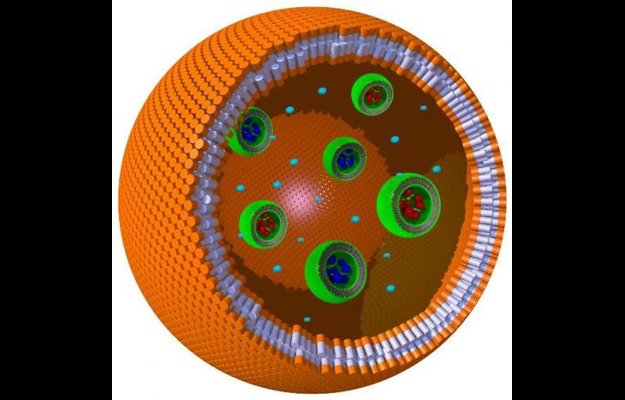
|
||
|
Plastic Cell
For something so tiny, a biological cell is a remarkably crowded place. In multi-celled creatures known as eukaryotes, each cell is packed with even smaller structures - organelles - that have specific functions, often related to controlling chemical reactions. To better understand cell chemistry, scientists at Radboud University Nijmegen in the Netherlands created the first artificial cell with actual working parts inside. They trapped tiny spheres filled with enzymes inside a water droplet and coated the whole thing with a polymer. The resulting "plastic cell" initiated a cascade reaction among the enzymes inside, essentially mimicking the way organelles function. ~excerpt and photo from: http://www.smithsonianmag.com/science-nature/ten-cool-science-stories-you-may-have-missed-2014-180953747/ Send this link to anyone you think would be interested in reading this entry. |

|
|||

|

|
||
|
Butterfly Orchid (Encyclia tampensis)
I love this little native Florida orchid. It grows naturally and wildly in my yard in several locations. It's always a delight in the summer when it starts to bloom. Details: This is a rather conspicuous epiphytic plant with pseudobulbs typically an inch or less in diameter supporting one (sometimes two) slender, grass-like leaves six to twelve inches long. Roots are slender and white when dry, and can run several feet up and down the branch where the plant grows. Flower stems emerge from within the leaf axil, to bear a raceme or panicle of attractive flowers, typically fragrant in the hours around noon. The flowers are 1 to 1.5 inches across, with green sepals and petals suffused with varying amounts of red, a tri-lobed lip with two lobes on either side of the column and the third lobe fan-shaped and typically blotched with purple. ~excerpt from: http://www.flnativeorchids.com/natives_gallery/encyclia_tampensis.htm If you want to harvest any for sale from the wild, you must get a permit. If you want to collect more than 2 for personal use from private lands, or any at all from public lands, a permit is required. original photo by dmdart |

|
|||

|

|
||
|
What is Art?
This is a photo of two little girls not looking at modern art in the San Francisco Museum of Art. (Perhaps they are looking for art in unseen places.) As Clement Greenberg, a strong champion of abstract expressionism, once said: "To hold that one kind of art must invariably be superior or inferior to another kind means to judge before experiencing; and the whole history of art is there to demonstrate the futility of rules of preference laid down beforehand: the impossibility, that is, of anticipating the outcome of aesthetic experience." The photographer of this image is unknown. It is thought to have been an image in Life Magazine prior to 1975. |

|
|||

|

|
||
|
Feeling a Holograph
It's no night on the Holodeck, but technology unveiled in December can let you see and touch a virtual sphere for the first time. Researchers used an ultrasound device to focus disturbances in the air created by sound waves into 3D shapes. The floating shapes are visible to the naked eye and create haptic feedback when you touch them. The work is still in an early phase, but the researchers anticipate that more advanced devices could create touchable CT scans and interactive museum displays. ~excerpt and photo from: http://www.smithsonianmag.com/science-nature/ten-cool-science-stories-you-may-have-missed-2014-180953747/ |
|
|
|
home |
photography |
3d art |
technology |
diverse |
archive |
comments |
dmdart.com |
zebis.com |
sitemap |
contact me by e-mail
|
| © 2014-2015 dmdart.com/blog : a very small division of Zebis, Inc. - All rights reserved. |